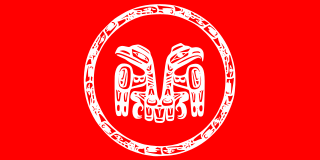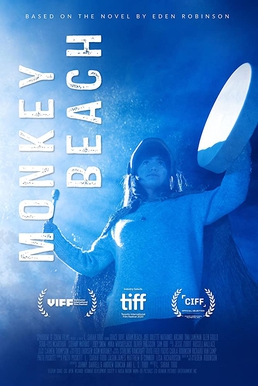
Haida are an indigenous group who have traditionally occupied Haida Gwaii, an archipelago just off the coast of British Columbia, Canada, for at least 12,500 years.
The Haida are one of the indigenous peoples of the Pacific Northwest Coast of North America. Their national territories lie along the west coast of Canada and include parts of south east Alaska. Haida mythology is an indigenous religion that can be described as a nature religion, drawing on the natural world, seasonal patterns, events and objects for questions that the Haida pantheon provides explanations for. Haida mythology is also considered animistic for the breadth of the Haida pantheon in imbuing daily events with Sǥā'na qeda's.

East of Eden is a novel by American author and Nobel Prize winner John Steinbeck. Published in September 1952, the work is regarded by many to be Steinbeck's most ambitious novel and by Steinbeck himself to be his magnum opus. Steinbeck stated about East of Eden: "It has everything in it I have been able to learn about my craft or profession in all these years," and later said: "I think everything else I have written has been, in a sense, practice for this." The novel was originally addressed to Steinbeck's young sons, Thom and John. Steinbeck wanted to describe the Salinas Valley for them in detail: the sights, sounds, smells and colors.

Haida Gwaii, formerly known as the Queen Charlotte Islands, is an archipelago located between 55–125 km (34–78 mi) off the northern Pacific coast of Canada. The islands are separated from the mainland to the east by the shallow Hecate Strait. Queen Charlotte Sound lies to the south, with Vancouver Island beyond. To the north, the disputed Dixon Entrance separates Haida Gwaii from the Alexander Archipelago in the U.S. state of Alaska.

Them is a novel by Joyce Carol Oates, the third in the Wonderland Quartet she inaugurated with A Garden of Earthly Delights. It was published by Vanguard in 1969 and it won the U.S. National Book Award for Fiction in 1970.

Eden Victoria Lena Robinson is an Indigenous Canadian author. She is a member of the Haisla and Heiltsuk First Nations.

Brandon Stark, also known as Bran, is a fictional character in the A Song of Ice and Fire series of epic fantasy novels by American author George R. R. Martin, and its television adaptation Game of Thrones, where he is portrayed by English actor Isaac Hempstead Wright. Introduced in 1996's A Game of Thrones, Bran subsequently appears in A Clash of Kings (1998) and A Storm of Swords (2000). He is one of a few prominent characters that are not included in the fourth novel A Feast for Crows (2005), but returned in the fifth novel A Dance with Dragons (2011).
Southern Ontario Gothic is a subgenre of the Gothic novel genre and a feature of Canadian literature that comes from Southern Ontario. This region includes Toronto, Southern Ontario's major industrial cities, and the surrounding countryside. While the genre may also feature other areas of Ontario, Canada, and the world as narrative locales, this region provides the core settings.

Raven Tales are the traditional human and animal creation stories of the indigenous peoples of the Pacific Northwest Coast. They are also found among Athabaskan-speaking peoples and others. Raven stories exist in nearly all of the First Nations throughout the region but are most prominent in the tales of the Haida, Tsimshian, Tlingit and Tahltan people.

The Messengers is a 2007 supernatural horror film directed by the Pang Brothers, and produced by Sam Raimi. It stars Kristen Stewart, John Corbett, William B. Davis, Dylan McDermott, Carter Kolbeck and Penelope Ann Miller. The film is about an ominous darkness that invades a seemingly serene sunflower farm in North Dakota, and the Solomon family—the owners of the farm—who are torn apart by suspicion, mayhem, and murder.

Many references to ravens exist in world lore and literature. Most depictions allude to the appearance and behavior of the wide-ranging common raven. Because of its black plumage, croaking call, and diet of carrion, the raven is often associated with loss and ill omen. Yet, its symbolism is complex. As a talking bird, the raven also represents prophecy and insight. Ravens in stories often act as psychopomps, connecting the material world with the world of spirits.
The Crow is a fictional superhero character and the protagonist of The Crow comic book series, originally created by American artist James O'Barr in 1989. The titular character is an undead vigilante brought back to life by a supernatural crow to avenge his murder and death of his fiancée.

Carnivàle is an American television series set in the United States during the Great Depression. The series traces the disparate storylines of a young carnival worker named Ben Hawkins and Brother Justin Crowe, a preacher in California. The overarching story is built around a good and evil theme, which serves as a human-scaled metaphor within a complex structure of myth and allegory. Samson, the carnival's dwarf manager, sets up the show's mythology with a prologue in the pilot episode, talking of "a creature of light and a creature of darkness" being born "to each generation" preparing for a final battle.
Beyond Eden is a musical written by Bruce Ruddell with music by Bruce Ruddell and Bill Henderson. It premiered February 16, 2010 at the Max Bell Theatre at the Epcor Centre for the Performing Arts in Calgary, Alberta, Canada and in Vancouver at the Vancouver Playhouse as part of the Cultural Olympiad. The show was first mounted by Theatre Calgary and ran until March 7, 2010. The Vancouver show ran from January 16 to February 6, 2010 and was well received for its cast, musical score and background projections.

Monkey Town: The Summer of the Scopes Trial is a 2006 novel written by American author Ronald Kidd. The story is set in summer 1925 in Dayton, Tennessee, and is based on the Scopes Trial.
Ravensong is a novel written by the contemporary Canadian author, Lee Maracle. It was published by Press Gang Publishers in 1993 and reissued by Canadian Scholars' Press/Women's Press in 2011.
Loretta Sarah Todd is a Canadian Indigenous film director. Todd has directed over 100 projects including documentaries, video games, animated media, and television shows.

Terri-Lynn Williams-Davidson is a Canadian indigenous lawyer, artist, activist and author and a member of the Raven Clan from the Haida Nation. As a lawyer, Williams-Davidson specializes in aboriginal-environmental law, having represented the Haida Nation at all levels of court since 1996 and notably participating in the litigation of the Haida Nation's TFL39 Case to protect the old-growth forests of Haida Gwaii, a case that effectively altered the government's stance on the consultation and accommodation of Aboriginal Rights.

Monkey Beach is a 2020 Canadian drama film, directed by Loretta Todd. Her debut narrative feature, the film is an adaptation of Eden Robinson's 2000 novel Monkey Beach.

The Raven and the First Men is a sculpture by Haida artist Bill Reid. It depicts the Haida creation myth. It was carved from a single block of laminated yellow cedar, beginning in the fall of 1978, and took two years to complete, with work completing on April 1, 1980. Raven and the First Men is depicted on the reverse of the former Canadian twenty dollar bill of the Canadian Journey series.













